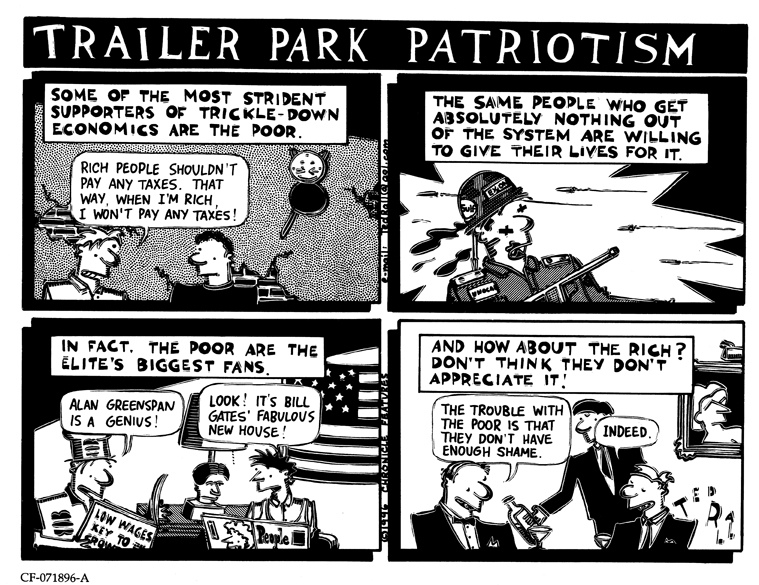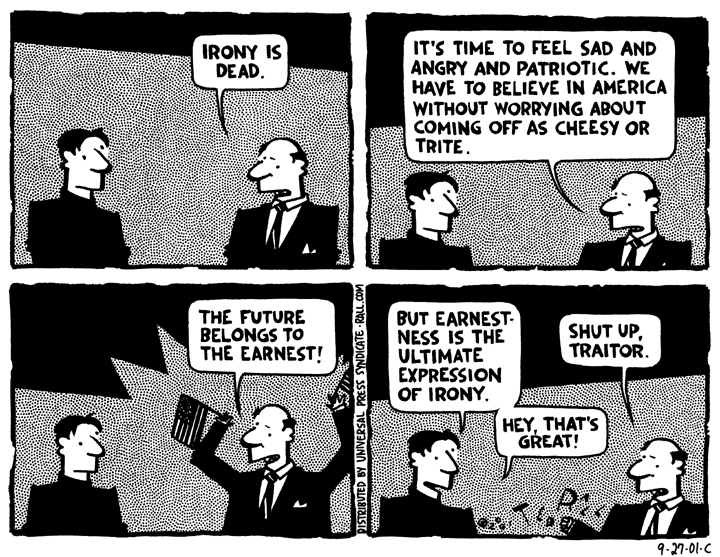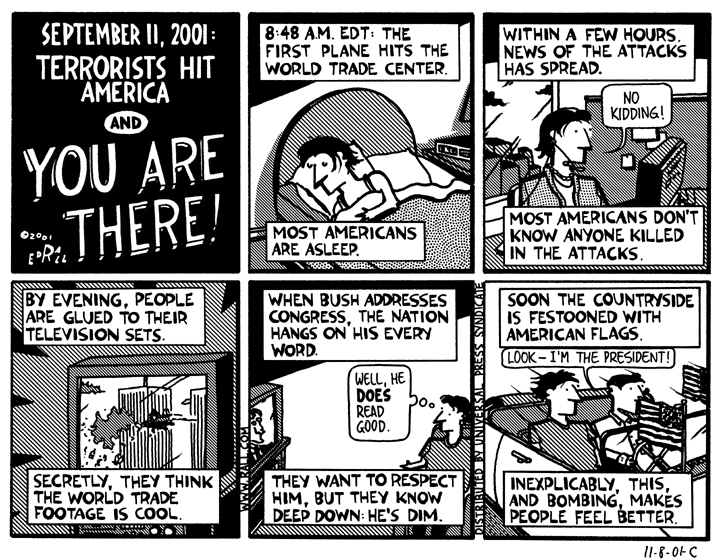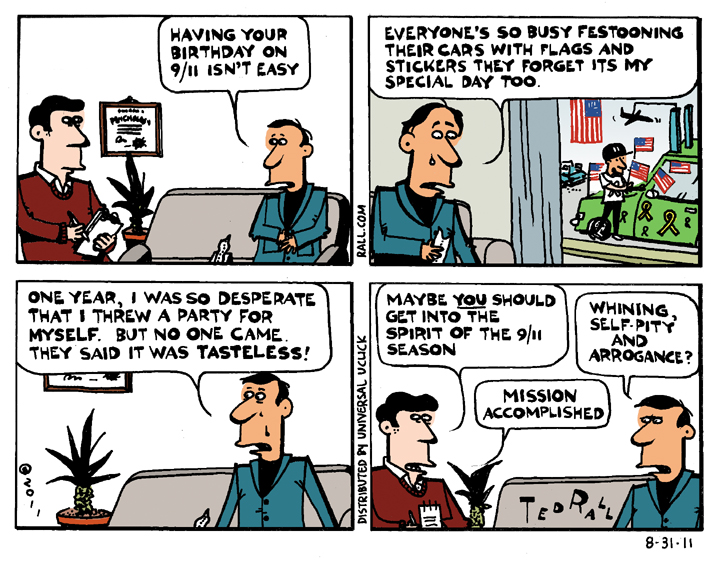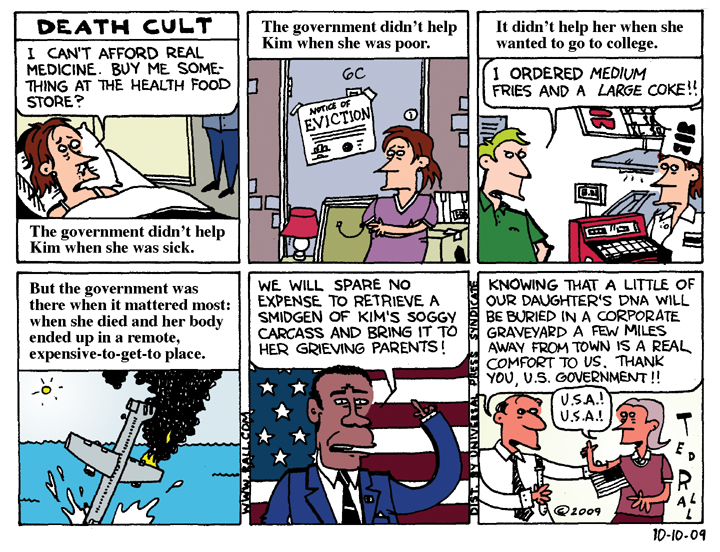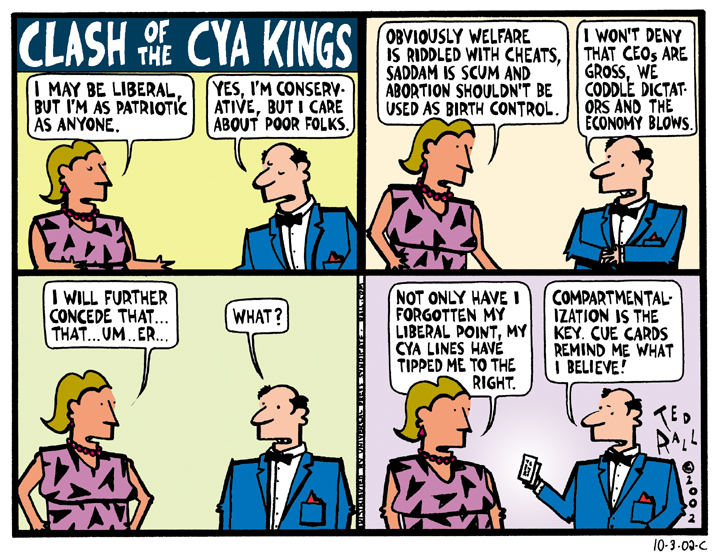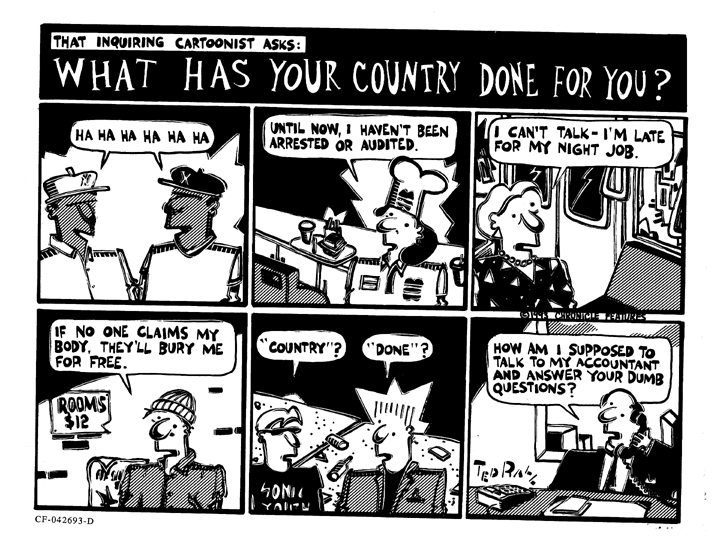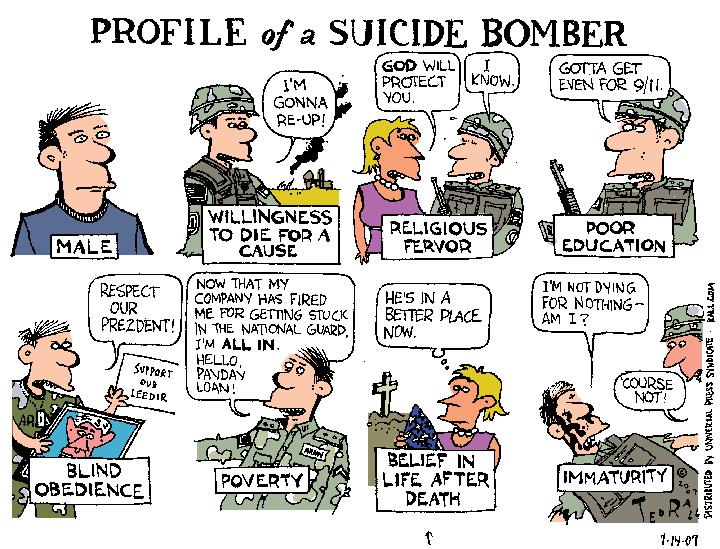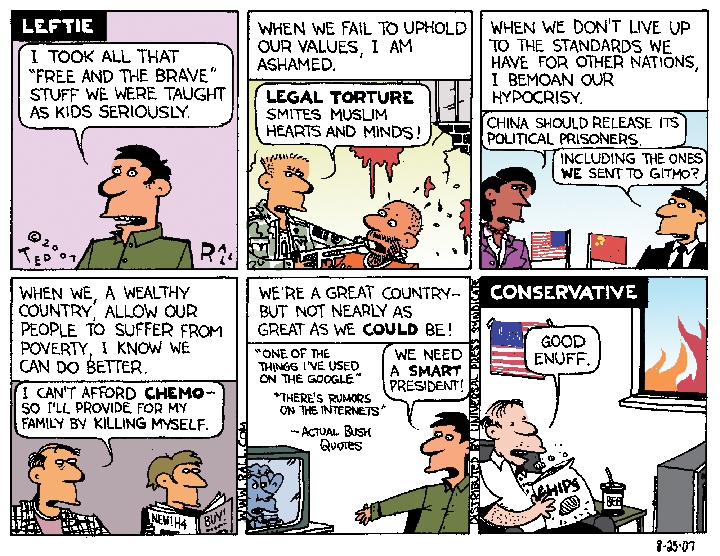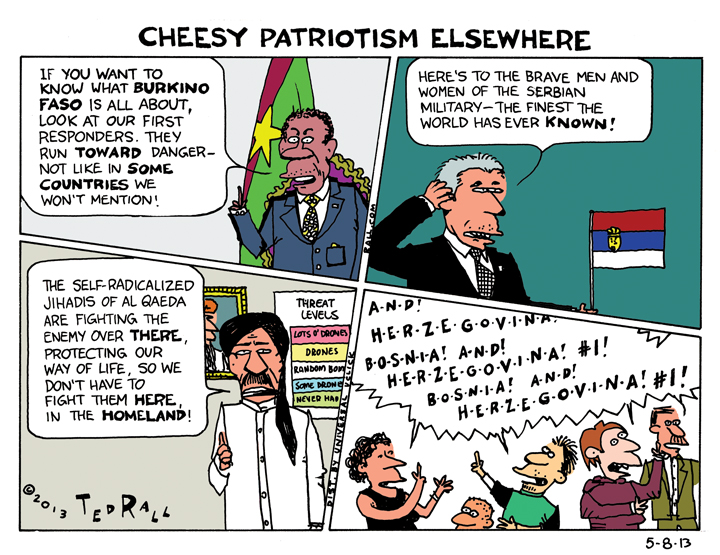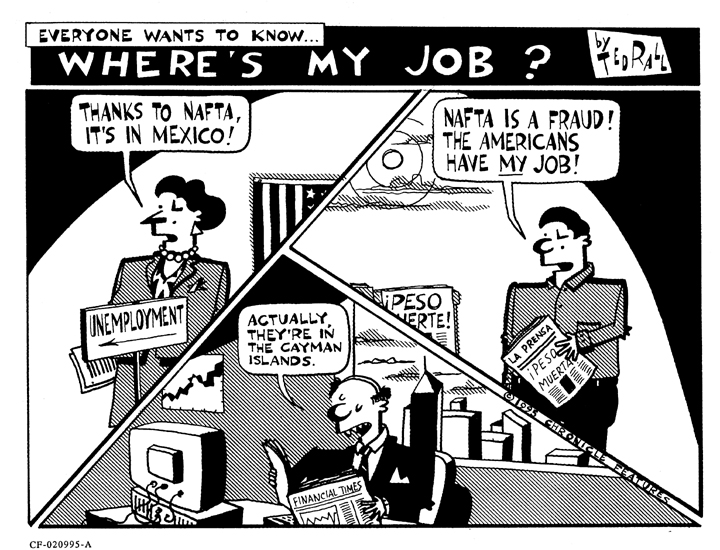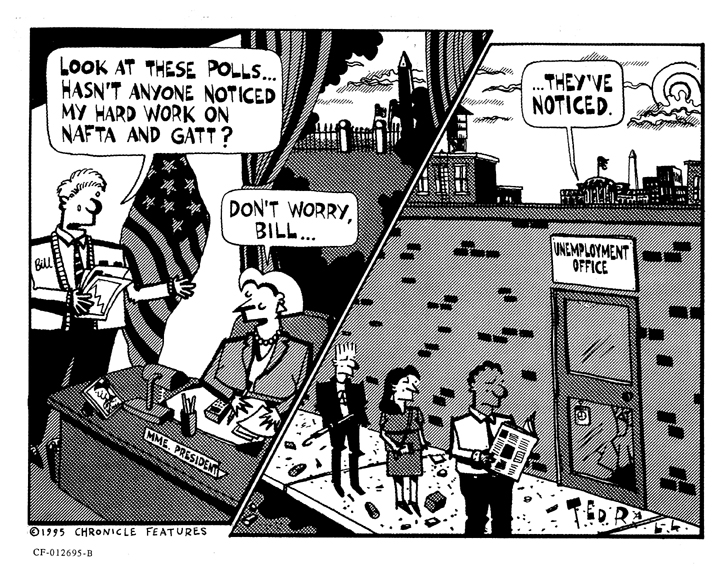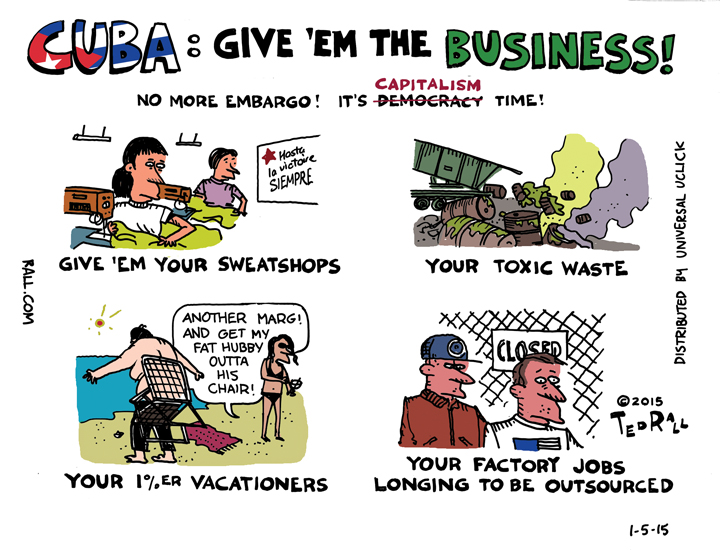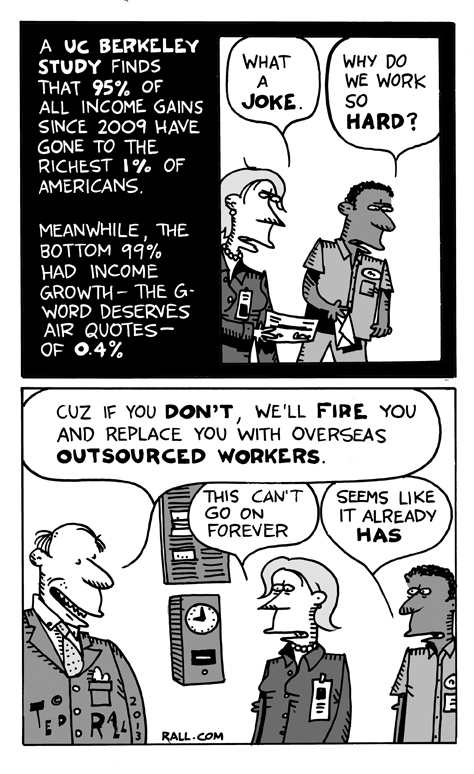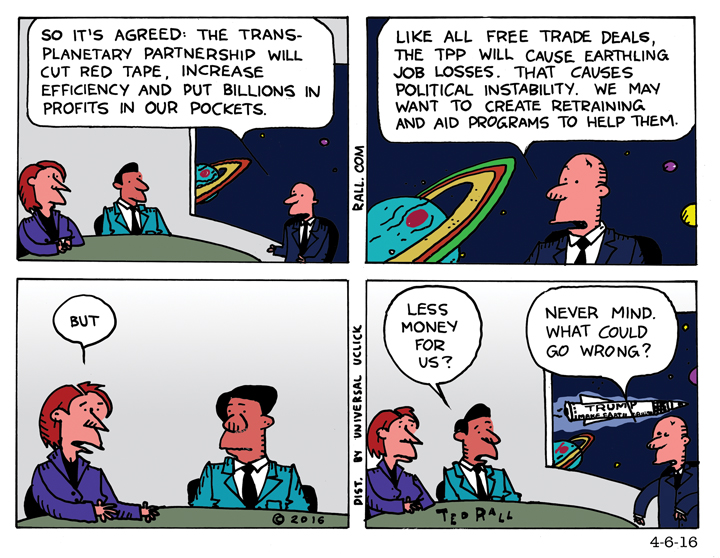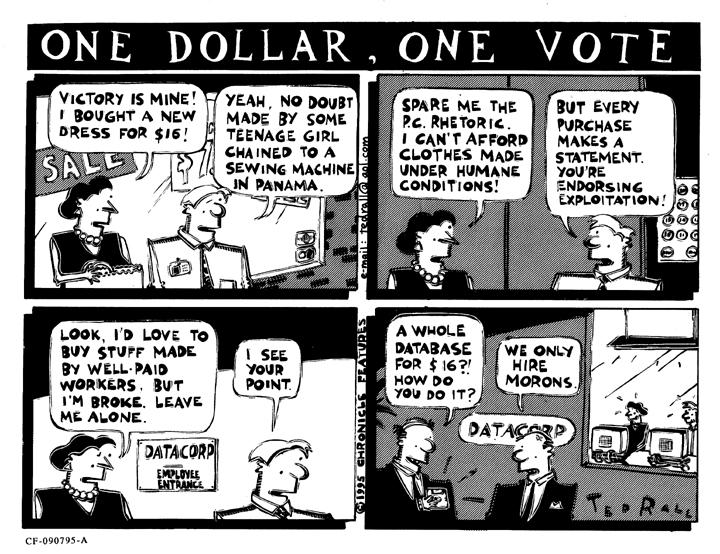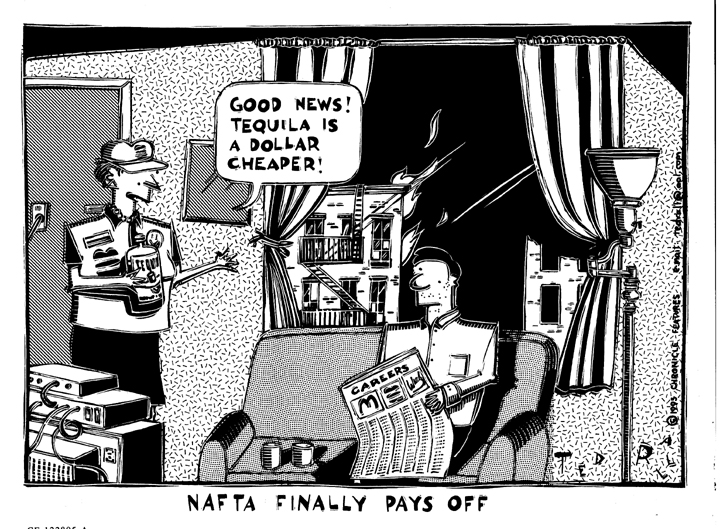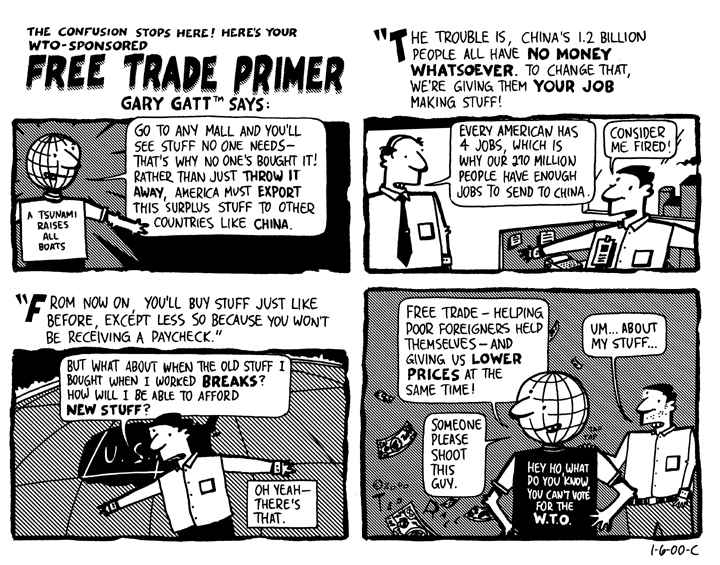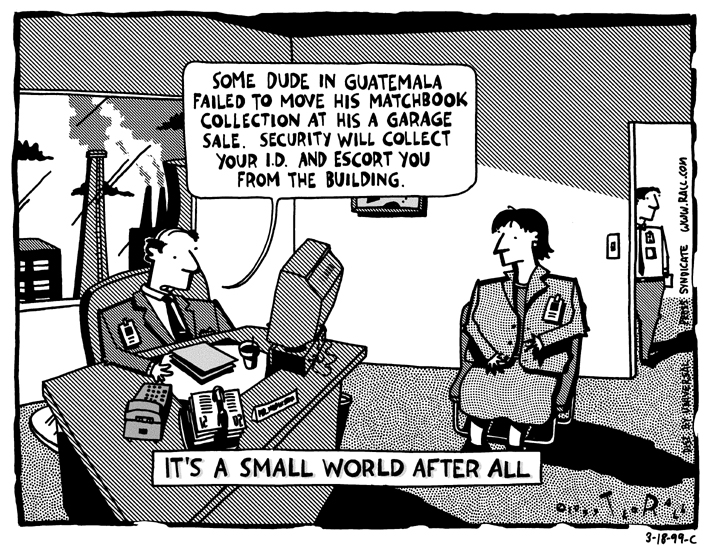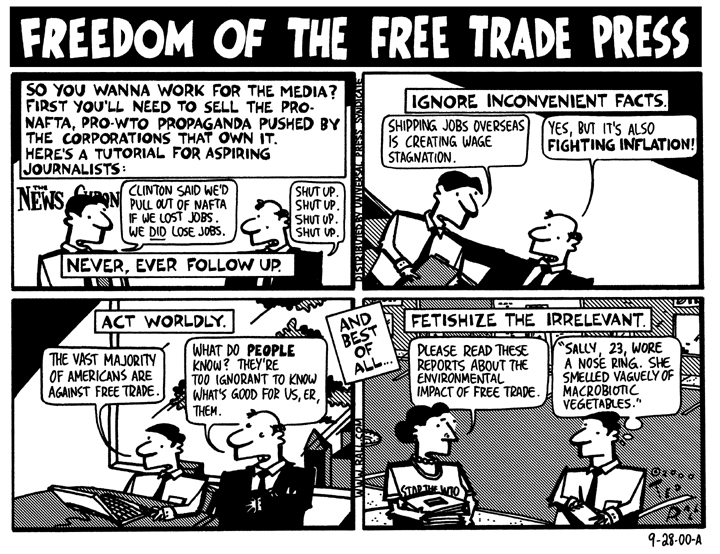This is one topic I’d really like to be able to retire: police brutality, racism and the viciousness of the system against the downtrodden. Here’s a selection of some of my “favorite” cartoons over the years about the po-po.
[slideshow_deploy id=’32708′]SYNDICATED COLUMN: Violent, Racist Cops Protect a Violent, Racist System
 Racism is complicated. When America’s most brilliant thinkers set out to explain its nature in terms as clear as the English language allows, as Michael Eric Dyson did in his searing July 7th essay “Death in Black and White,” even the relatively sophisticated readers of the New York Times didn’t get it. Commenters didn’t understand that Dyson wasn’t criticizing every white person, but “white America” — shorthand for a dominant power structure that is fundamentally racist while (of course) not every white person is.
Racism is complicated. When America’s most brilliant thinkers set out to explain its nature in terms as clear as the English language allows, as Michael Eric Dyson did in his searing July 7th essay “Death in Black and White,” even the relatively sophisticated readers of the New York Times didn’t get it. Commenters didn’t understand that Dyson wasn’t criticizing every white person, but “white America” — shorthand for a dominant power structure that is fundamentally racist while (of course) not every white person is.
If anti-racist white people take writing as straightforward as Dyson’s personally, if they take offense at his passion and so miss his message, is there any hope of “black America” and “white America” just getting along?
It’s been a hell of a week. Two more black men, Alton Sterling and Philando Castile, were gunned down by the police under the usual incomprehensible circumstances — events the media, and thus the government, are paying attention to only because someone invented the smartphone. Then a 25-year-old sniper, a veteran of America’s brutal war against Afghanistan, shot 12 police officers at a march in Dallas protesting the deaths in Minnesota and Louisiana. Five died.
Needless to say, the Dallas cops didn’t have it coming. They didn’t have anything to do with what happened in entirely different states.
Well, it shouldn’t need to be said. But it does. Because, no matter how many times we hear public officials tell us that the police protect and serve us, it doesn’t ring true. Three out of four African-Americans tell pollsters they don’t think police are held accountable for their actions. So do 40% of whites.
The truth is, Americans don’t like cops.
Let’s be honest. If we think about them at all, we don’t mourn the slain Dallas police officers as deeply as we did the children who died in the day care center blown up in Oklahoma City, or the nightclubbers murdered in Orlando.
We need to talk about why that is.
We have been hearing more about racial profiling, how blacks are targeted by police officers more than whites, how they are physically assaulted more often, how they are charged with more serious crimes for the same offenses, how they get longer prison sentences and harsher fines. Good. This discussion is long overdue. Way too many people still don’t get it.
It is right and proper to focus on Black Lives Matter. To say it. To believe it. A retort that All Lives Matter is far worse than pabulum. Because it distracts from a point that still hasn’t received proper consideration in the media or in electoral politics, All Lives Matter is racist. Even the first black president has addressed the racism behind police violence only in “it sure is sad, we should do better” niceties rather than meaningful, sweeping policy changes. (He could start with blanket presidential pardons of black inmates serving ridiculously long prison sentences.) Black Lives Matter. That’s what we need to talk about now. For a good long time, too.
One possible place to start is the reaction of many people to the Dallas sniper attack. Like 9/11, it was shocking. Like 9/11, it also wasn’t surprising. You can’t go on acting like a bully forever. The powers that be can’t pressure their victims forever. Eventually the prey strike back. No, it isn’t justified. Nor is it right. But it is chickens coming home to roost.
Like the Bush Administration after 9/11 (“Why? Why do they hate us?”), the police and the political elites the police actually protects and serves look silly when they pretend that they can’t possibly imagine why anyone might dislike them. “There is no possible justification for these kinds of attacks or any violence against law enforcement,” President Obama said after Dallas. No justification? Sure.
No possible justification? Before they blew him up with a robot bomb in an extrajudicial assassination (there weren’t any hostages), suspect Micah Johnson told police negotiators that he was “upset about the recent police shootings…[that] he wanted to kill white people, especially white officers.” You’d have to be especially thick, or really really white, not to see why a black guy might snap after watching the Alton Sterling and Philando Castile snuff videos.
Obama continued: “Anyone involved in the senseless murders will be held fully accountable. Justice will be done.” Naturally, Obama was referring only to justice for the murdered police officers. There’s never any justice for those murdered by police officers (c.f., Freddie Gray, Michael Brown, Walter Scott, Eric Garner, etc.).
There’s a lot to worry about in all this. As for me, I’m concerned that the true nature of the police, the roots of its brutality in its role as the armed guards of the ruling classes, has been obscured by the racial divide. Racism is real. It’s complicated.
So is class warfare.
Even if you are privileged as I am – white, male, able-bodied, Ivy League-educated – odds are that your interactions, like mine, with the police are generally unpleasant. Mostly, I run into them when they pull me over to give me a ticket. If I’m lucky, they are merely rude, overbearing, aggressive and condescending. Once in a blue moon, a cop manages to be merely gruff. And I’m lucky. I’ve seen the way cops act in black neighborhoods. It’s much, much worse. They’re disgusting.
I had a bad experience with a Los Angeles police officer in 2001. He arrested me for jaywalking — falsely. He roughed me up and handcuffed me. This being America, I couldn’t help wonder whether he might have targeted me because he was black and I was white. But he never said anything that indicated that. Maybe he had a quota to fill.
Black or white, the police are paid to oppress, not protect. Black or white, citizens have good cause to be afraid of them. That’s the nature of the system. It’s another reason the system has got to go.
(Ted Rall is the author of “Bernie,” a biography written with the cooperation of Democratic presidential candidate Bernie Sanders. His next book, the graphic biography “Trump,” comes out July 19th and is now available for pre-order.)
SYNDICATED COLUMN: Hillary Cheated

Who are you going to believe: us, or your lying eyes? That’s the good word from Democratic Party powers that be and their transcribers in the corporate media, in response to the “allegations” by Bernie Sanders supporters that the nomination was stolen by Hillary Clinton.
I used scare quotes around the word “allegations” because the truth is plain to see and undeniable by anyone with a microgram of honesty: Hillary Clinton cheated. If the rules had been followed, Bernie Sanders would be the nominee.
As with all things Clinton, of course, definitions matter. It depends on what the meaning of “cheat” is.
To most people, “cheating” means breaking the rules of a contest. By this standard definition, there’s no doubt that the Clinton campaign, its political allies and the Democratic National Committee cheated in favor of Clinton and against Sanders. They broke the law. They disenfranchised voters. They broke party rules. And they violated long-standing customs that are so widely accepted that they are essentially de facto rules of the Democratic Party and the American political system.
Bernie Sanders, on the other hand, ran a clean campaign.
Like many other voters, I subscribe to a somewhat broader definition of cheating in political elections. To me, Richard Nixon-style “dirty tricks” – the disgusting tactics George W. Bush used against John McCain in South Carolina in 2000 – rise to the level of cheating because they deny voters the facts that they need in order to make an educated decision in the voting booth. Daniel Patrick Moynihan famously said that people are entitled to their own opinion, not their own facts, and outright lies about your opponent’s – and your own – positions and experience not only violate Moynihan’s dictum but constitute the essence of cheating in the political arena.
If Hillary Clinton manages to dodge both an Emailgate-related indictment as well as fallout from her husband’s corrupt tarmac rendezvous with the now-tainted Attorney General Loretta Lynch for the next few weeks and formally secure the nomination she’s been working on since at least the year 2000, it will be a historic moment for identity politics. But it is absolutely imperative that no one watching the first woman to accept the presidential nomination of a major American political party be fooled into believing that she did it on the up and up.
Hillary Clinton did not run a clean campaign.
She cheated.
If we want to be the kind of country that doesn’t care about that sort of thing, if fair play isn’t an American value, fine with me. But let’s go into this general election campaign with our eyes wide open.
Caucus after caucus, primary after primary, the Clinton team robbed Bernie of votes that were rightfully his.
Here’s how. Parties run caucuses. States run primaries. The DNC is controlled by Hillary Clinton allies like chairman Debbie Wasserman Schultz. Democratic governors are behind Clinton; state election officials report to them. These officials decide where to send voting booths, which votes get counted, which do not.
You thought this was a democracy? Ha.
In the first in the nation Iowa caucus, Bernie Sanders pulled off a surprising tie where he was expected to lose badly — Hillary won by just 0.2%. However, party officials never bothered to send vote counters to the most rural parts of the state, where Bernie was favored over Hillary. About 5% of Iowa caucus votes were never counted. At other caucus sites, Democratic officials loyal to Hillary purposefully undercounted Sanders caucusers. No doubt about it, Bernie should have won that one, as well as votes in other states that would have been affected by a big Sanders upset.
Voters in pro-Sanders precincts in Arizona faced long lines because pro-Hillary elections officials didn’t provide enough voting booths. With lines of three hours or more still to go, the media called the state for Hillary.
New York State was arguably the most important contest of the primary season. Had Bernie Sanders defeated Hillary Clinton in her adopted home state where she had served 1 1/3 terms as senator, he would have dealt her campaign a blow from which she might never have recovered, along with a pile of delegates. Because of her local roots and the fact that New York was a closed primary state in which independence were not allowed to vote, it was a long shot for Bernie. But like the LAPD in the O.J. Simpson case, the Clinton team wasn’t taking any chances.
Did they drop a line to Governor Andrew Cuomo, who endorsed Clinton? Or did state elections officials act on their own initiative? Either way, Bernie Sanders stronghold, the borough of Brooklyn where he was born, was targeted for massive voter suppression. At least 125,000 New Yorkers were illegally purged from the rolls, had their votes lost/thrown away, or were not permitted to vote due to broken voting machines – all in Brooklyn.
Even Mayor Bill de Blasio, who endorsed Clinton, was angry. “It has been reported to us from voters and voting rights monitors that the voting lists in Brooklyn contain numerous errors, including the purging of entire buildings and blocks of voters from the voting lists,” De Blasio said. “The perception that numerous voters may have been disenfranchised undermines the integrity of the entire electoral process and must be fixed.”
The skullduggery continued through the last major primary, California. The night before, the Associated Press put its thumb on the scale, declaring Hillary the nominee in an epic act of voter suppression. Who knows how many Sanders voters decided to stay home once they heard it was all over?
Hillary Clinton was declared the winner by a substantial margin, but after it turned out that state election officials, who report to Governor Jerry Brown, who endorsed Clinton, didn’t bother to count a whopping 2.5 million provisional ballots. According to investigative journalist Greg Palast, the nation’s leading expert on the manipulation of elections, Bernie Sanders actually should have won the state of California along with the majority of its delegates. (Disclosure: I work with Palast as a Fellow of his Investigative Fund.)
One of the most disreputable moves of the campaign was the Associated Press poll of party superdelegates, party insiders who are allowed to vote for whoever they want but, because they are party insiders, inevitably support the establishment candidate. Truth is, the superdelegate system itself is official cheating. But the AP survey made a terrible system even more deadly to democracy.
If they cared about free elections, the superdelegates wouldn’t have stated their loyalty in public. The DNC ought to have told superdelegates that they would lose their status if they expressed their opinions before the convention. As it was, Bernie Sanders started the race miles behind the finish line.
The only way Bernie could have caught up would have been to have scored one landslide win after another. As it was, he came close to doing that. His surprising early momentum, big rallies and popularity with younger voters might have convinced superdelegates to back him, but after they told the AP they were for Hillary Clinton, it was too late for them to change their minds.
I’m out of space. So I can’t get into the DNC’s attempts to deny Bernie Sanders airtime in the form of widely seen debates against Hillary Clinton, her ridiculous claim that she supported Bernie’s $15-an-hour federal minimum wage at the same time that her website confessed that she didn’t, the Nevada Democratic convention in which Sanders supporters were denied seats by Clintonites in charge and then falsely accused of violence, and Clinton’s sleazy “I was for the TPP before I was against it, and now that the primaries are over, I’m for it again” gambit.
That stuff isn’t the usual hardball.
It’s cheating.
(Ted Rall is the author of “Bernie,” a biography written with the cooperation of Democratic presidential candidate Bernie Sanders. His next book, the graphic biography “Trump,” comes out July 19th and is now available for pre-order.)
SYNDICATED COLUMN: Who’s Really To Blame for Brexit (and Trump)
 At this writing, securities markets and the international community are reeling at the news that British voters have opted to leave the European Union. The “Brexit” has provoked angry reactions from the pro-Remain camp, who accuse Leave voters of stupidity, shortsighted ignorance and, worse, thinly-disguised racism and nativism posing as nationalism.
At this writing, securities markets and the international community are reeling at the news that British voters have opted to leave the European Union. The “Brexit” has provoked angry reactions from the pro-Remain camp, who accuse Leave voters of stupidity, shortsighted ignorance and, worse, thinly-disguised racism and nativism posing as nationalism.
Political analysts point out that British voters were divided geographically – Scotland wanted to stay, England wanted to leave – as well as demographically. One chart that managed to go semi-viral online displayed high support for the Brexit among older voters, opposition among the young, alongside the actuarial average years remaining that each age group would have to live with the consequences of the vote. The smartest of these pundits focus on the class divide between shiny expensive youth-oriented cities like London, where pro-European sentiments are strong, and England’s version of the Rust Belt, abandoned hellholes where citizens barely subsist in a ruined landscape of shut down factories and widespread unemployment.
“If you’ve got money, you vote in,” a voter in Manchester told The Guardian. “If you haven’t got money, you vote out,” she said.
Amid all the concern about a collapsing British pound and the possible dissolution of not only the European Union – looks like France and the Netherlands may have a similar plebiscite in the near future – but also the United Kingdom, everyone’s out to cast blame. However, no one is pointing at those who are most responsible if (and it’s far from certain) Brexit leads to an economic downturn and/or a political debacle: the West’s incompetent political class, and its idiotic enablers in the corporate media.
The postwar order began to fray during the 1970s, when business leaders and their allies in government started to push aggressively for policies that encouraged the transfer of manufacturing industries to the developing world away from what was then called the First World in preparation for what we now call the information economy. Globalization is the shorthand term for deindustrialization – some call it outsourcing, others prefer the simpler “shipping jobs overseas” – and digitalization of culture and intellectual property.
This essay isn’t about whether globalization is good or bad. It’s about the way a trend that has been consistently declared irreversible has been poorly managed. That mismanagement led to the Brexit, and may elect Donald Trump.
Even during the 1970s, globalization’s downward pressure on wages was easy to foresee. Capital was becoming increasingly fluid, crossing borders with incredible ease in search of places and people where the production of goods and services could be done as cheaply as possible. If you own a factory in Michigan, and you can figure out a way to transport your product to market at reasonable cost, doing the patriotic “made in USA” thing feels like leaving money on the table when you consider what your expenses would look like in Vietnam or Indonesia.
Workers, on the other hand, are confined by international borders, linguistic and cultural limitations, family ties, and just plain inertia, to the nations — and often the regions within those countries — where they were born. If the highest wages in the world are paid in the United Arab Emirates, you can’t just hop on a plane and expect to find a job, much less a work permit. Workers are stuck; capital moves freely. This economic imbalance between labor and management is a significant contributing factor to the decline in real median wages in countries like Great Britain and the United States since the 1970s.
Now let’s say that you’re a high-ranking member of the ruling class: a Fortune 500 CEO, a head of state, a congressman, the publisher of a big-city newspaper. You don’t need a major in history or political science in order to anticipate that subjecting tens of millions of people to long-term unemployment and underemployment is a recipe for social dysfunction and the kind of class resentment that can be exploited by a demagogue or radical populist movement.
You can do one of two things with that knowledge. You can ignore victims of economic dislocation. Or you can help them.
If you ignore them, if you greedily grab up every dollar and pound and euro you can while city after city slowly collapses into alcoholism, drug abuse and rising crime, you know you’re setting yourself up for a future of political instability. It may take a long time, but the chickens will come home to roost. When things turn ugly, it could cost you a pile of cash you amassed during your orgy of greed.
That’s what happened during the 1980s, when Margaret Thatcher and Ronald Reagan dismantled the post-World War II social safety nets. Precisely at a time when the UK and the US needed more welfare, national healthcare and public education programs, they slashed them instead. Those austerity policies continued under Tony Blair, Bill Clinton, David Cameron, and – against reason and common sense – under Barack Obama after the 2008 economic meltdown.
The British and American political classes made a conscious decision over the last 40 to 50 years not to lift a finger to help those who lost their jobs to deindustrialization and globalization. Go back to college, they say. Get retrained. But most Americans can’t afford college tuition — the jobless least of all! We need(ed) a GI Bill for the dispossessed.
Even this week, many establishment types continue to criticize aging pensioners and unemployed workers over age 50, denigrating them as selfish, clueless, unwilling and unable to adapt themselves to the new – brutal – world in which we find ourselves.
No doubt: nativism and racism played a role in the Brexit vote. England is an island nation with an island mentality. Though only a few thousand Syrians entered the UK last year, with nary a passport check, images of refugees riding the roof of trains from France through the Chunnel felt like an invasion to some Britons. But bigotry shouldn’t let us ignore the economic factor. When jobs are plentiful and salaries are rising, no one minds immigration. Xenophobia grows in the soil of scarcity.
What did the elites think? Did they really believe it was possible to make so many people so desperate and so angry for so long without a risk of them lashing out?
Donald Trump is not a brilliant man. But the political classes could learn a lesson from him. He knows that an awful lot of people are angry. And he knows why.
(Ted Rall is the author of “Bernie,” a biography written with the cooperation of Democratic presidential candidate Bernie Sanders. His next book, the graphic biography “Trump,” comes out July 19th and is now available for pre-order.)
SYNDICATED COLUMN: Mass Shootings Are The New Normal. Get Over It.
 What is wrong with Americans?
What is wrong with Americans?
Okay, that’s a very open-ended question with many potential answers.
What I’d like to talk about this time is: why is it that Americans only begin to get serious about a problem after it’s too late to solve it?
Currently, I’m thinking about the latest, depressingly predictable response to the Orlando massacre.
As usual, right-wingers like Donald Trump want to restrict immigration. But even setting aside the obvious moral and practical economic objections to nativism, how would that prevent future mass shootings (in part) in the name of the Islamic State? Orlando shooter Omar Nateen wasn’t an immigrant. He was born in Queens, New York; his parents were from Afghanistan. If the Republicans’ goal is to get rid of potentially self radicalized Muslims, it’s too late. There are 3.3 million Muslims in the United States. Many are full-fledged citizens.
Any group of people that numbers in the millions includes some who are mentally ill, some who are politically radical, some who are religious fundamentalists, and some who are some combination of all three. Since it’s illegal to deport U.S. citizens, millions of whom are Muslim, a few of whom are crazy – and the United States insists on pursuing an endless “war on terror” against Muslim countries – there’s no way that a policy of reduced immigration can prevent future attacks by homegrown Islamists.
On what passes for a Left, Democrats like Hillary Clinton are pushing for tighter restrictions on guns. As usual.
Indeed, it’s hard to argue that civilians require military grade weapons like the semi-automatic AR-15 assault rifle used to kill 49 people at the Pulse nightclub. Hunters don’t use them. If the AR-15 is legal, why not hand grenades? Had Nateen been forced to use a pistol or long gun instead, his bullets would have been smaller, the death toll lower. Some of his victims might have been able to overpower him as he tried to reload.
Here again, however, it’s too late to fix the problem. The cat is out of the bag. Two years ago, the national sport shooting foundation estimated that there were between 5 million and 8.2 million assault-style rifles in American homes. Sales of these weapons always spike after mass shootings, so it’s a safe bet that that number has risen by at least 1 million or two since then.
Even if Hillary Clinton were to succeed beyond her wildest dreams, assault weapons were banned permanently, what about those millions of AR-15’s already in circulation? Would she be willing to send jackbooted federal thugs door to door to search every home until every last one of them, or at least the lion’s share, were rounded up and melted down? Of course not.
The truth is, this ship sailed back in 2004 when Congress allowed the federal ban on assault weapons to expire without being renewed. Congress’s failure to act over the last 12 years has transformed the United States into a nation awash in military hardware.
Mass shootings are the new normal. Get over it.
“It’s too late to do anything about it, now let’s act” mania appears to have become as much of a part of our national character as the myth that everyone is a member of the middle class.
Progressives and liberals who form the base of the Democratic Party, most of whom supported Bernie Sanders during the primaries, are engaged in a robust debate over whether to switch over to Hillary Clinton this fall, support a third-party candidate like Green Party presidential nominee Jill Stein, or stay home on election day. It’s the same old question: Do you vote for the lesser of two evils? Isn’t that voting for evil?
Democrats for Clinton are trying to convince Bernie Sanders voters that November represents an existential threat, that if Donald Trump is elected everything we know and love about America will be destroyed. They don’t get it.
What the Clintonites don’t understand is that it’s already too late. Yes, if Donald Trump gets in, there’s a strong danger that what’s left of American democracy will yield to something radically new and terrifying, full-fledged authoritarianism. But Hillary Clinton also represents something horrible: a continuation of the neoconservatism that led to the invasion of Iraq, has made the United States a target of Islamist terrorism, complete capitulation to the banking class whose power structure relies upon the vast majority of American workers toiling for longer hours and shrinking wages – in effect, the last nail in the coffin of the idea that ordinary people have the right to imagine themselves and their children living better than they have in the past.
The existential battle isn’t in November. It was a couple of weeks ago, when Hillary Clinton appeared to nail down the Democratic presidential nomination. Whatever happens now, whether authoritarian Trumpism or steady-as-she-goes downwardly mobile Clintonism, we are screwed.
Perhaps no issue better illustrates my point than climate change.
I remember watching Jacques Cousteau on television in the 1970s, when he repeatedly warned that the oceans (along with the rest of the planet) were warming, and that it would soon – might already be – too late to stop it. The politicians and corporate executives, of course, ignored him and the other scientists who said the same thing. Now, finally, the political class is giving lip service to the crisis, though action remains in short supply.
The fact is, Cousteau was probably right. It was probably too late to save the planet back then. It’s certainly too late now. The climate science is clear. The polar ice cap is never coming back; Antarctica is melting away. The process can’t be reversed. Even if every internal combustion engine in the world stopped running tomorrow morning, human beings have pumped too much energy into the closed system that is our atmosphere to reverse global warming.
My intention isn’t to bum you out. All I’m saying is, let’s stop focusing on problems we can’t do anything about and work on those we still can.
(Ted Rall is the author of “Bernie,” a biography written with the cooperation of Democratic presidential candidate Bernie Sanders. His next book, the graphic biography “Trump,” comes out July 19th and is now available for pre-order.)
SYNDICATED COLUMN: What Hillary Must Do to Win Over Bernie Voters
 Unless you follow politics closely, you could be forgiven for thinking that Hillary Clinton has locked up the Democratic presidential nomination. This is not true. She still doesn’t have the requisite number of delegates. That could, and probably will, happen next month when her lead in superdelegates puts her over the top at the Democratic National Convention in Philadelphia – when the superdelegates actually, you know, cast their actual votes.
Unless you follow politics closely, you could be forgiven for thinking that Hillary Clinton has locked up the Democratic presidential nomination. This is not true. She still doesn’t have the requisite number of delegates. That could, and probably will, happen next month when her lead in superdelegates puts her over the top at the Democratic National Convention in Philadelphia – when the superdelegates actually, you know, cast their actual votes.
The media, however, doesn’t want you to know that Bernie Sanders is still in the race. And so, based on that flimsiest of measures – an opinion survey of superdelegates who are allowed to change their mind at any point before July’s DNC – they’ve called the Democratic race for Clinton.
This completely illogical reasoning logically leads pundits to the question of the month: how can the Hillary Clinton campaign convince progressive supporters of Bernie Sanders – whose race was largely based on the assumption that Clinton is so far to the right that she might as well be a Republican – to vote for her?
Every four years mainstream political writers and commentators push Democrats to the right after the primaries, arguing that swing voters decide presidential elections. Like trickle-down economics, however, that doesn’t seem to have been true any time in the recent past. Political parties seem to perform best when they motivate their base to turn up at the polls. Given the fact that Republican voters are congenitally more likely to fall in line behind their nominee even if he turns out to be a potato – or, this year, a proto-fascist – than Democrats, it’s obvious to everyone that Hillary Clinton will need as many Bernie Sanders supporters as possible in November if she indeed becomes her party’s nominee.
Obvious to everyone but Hillary.
Last week, NBC’s Lester Holt asked her about Sanders: “Can you name one idea that he’s put forward that you want to embrace? That he has really changed your position on?”
Her answer: a big fat negatori.
“Well, it’s not that so much as the passion that he brought to the goals that–his campaign set,” said Clinton.
Granted, I can’t think of anything she could do to get me to vote for her. But there are millions of Sanders voters who could be convinced not to sit home on election day, support a third-party candidate like Jill Stein or Gary Johnson, or defect to Donald Trump. She’ll need those voters if there are any more Orlando-style terrorist attacks (great for Trump’s fear-based campaign) or, for that matter, after presidential debates in which I expect Trump to savage her.
Maybe Debbie Wasserman Schultz can schedule those debates for the middle of the night on Kazakhstani state television.
Except when she’s hanging out with investment bankers and Walmart board members, Hillary Clinton reflexively refuses to compromise. If she continues her “I have nothing to learn from Bernie and he’ll be lucky to get a speech at the convention” attitude, however, better get prepared for President Trump.
What do Bernie Sanders supporters want? As Trump says, everything is negotiable. So let’s negotiate!
“Add back the public option to the Affordable Care Act,” Howard Dean suggests to Hillary in the New York Times. “Let Americans vote with their feet about whether they want to be in a single payer or the current system.”
The problem with that is, big insurance companies bribed her with $13 million in campaign contributions to get her to say that single payer “will never, ever come to pass.”
Dean wants Clinton to back Sanders’ “massive overhaul of the criminal justice system, starting with emptying for-profit prisons and juvenile detention centers.”
Nice idea, except that here too, she’s owned: she collected as many big donations from lobbyists for the for-profit prison industry as Marco Rubio.
He also wants her to embrace Bernie’s push for reforming Wall Street – but how likely is it that someone who made over $100 million giving speeches to scumbags in the financial services industry will turn against her backers?
“She should release the transcripts of her speeches and explain any of the objectionable things she said in them,” says Stephanie Rioux. If Clinton were going to show us her speeches, it would already have happened.
It may not feel like it now, but Hillary Clinton is in a pickle.
Her supporters keep citing her willingness to support Barack Obama after her defeat in 2008 as an example Bernie Sanders ought to emulate now. But Clinton and Obama were ideologically virtually identical. Both were members of the right-wing Democratic Leadership Council. True, Obama pretended to oppose the Iraq war, which Clinton supported. But Obama wasn’t in the Senate in 2003. When he did get the chance to vote on Iraq, he voted six times out of six in favor of funding it. And he continued the war long after he took office.
Conversely, there’s a huge gap between Clintonism and Sandersism. Bernie Sanders is essentially a Democrat circa George McGovern in 1972: he favors big government antipoverty programs, socialized medicine, and a limited role for the US military overseas. He’s skeptical of free trade agreements, and hasn’t met a Wall Street banker that he likes. Hillary Clinton isn’t just against all that – she’s diametrically opposed, essentially a Republican circa George W. Bush in 2003, many of whose advisers she shares.
“Sanders supporters…are motivated not by animosity toward Hillary Clinton but by a sophisticated analysis and belief that the system is irreparably broken and compromised,” says Sanderista Jonathan Tasini. Actually, only the second half of that sentence is true. As anyone who has attended a Bernie rally can tell you, there’s plenty of animosity toward Clinton.
So what does Hillary Clinton do if she wants to win?
She’ll have to sell out some of her big corporate donors – and she’ll have to do it in a big way. If she goes big, she could appoint Bernie Sanders as her vice president – a sure path to victory – or as an economic czar, like giving him both the secretary of the treasury and the head of the Federal Reserve Bank.
Failing that, she’ll have to adopt at least a few of Bernie’s major platform planks. But here’s the rub. Even if she does, are Bernie’s supporters naïve enough to think that she would follow through?
(Ted Rall is the author of “Bernie,” a biography written with the cooperation of Democratic presidential candidate Bernie Sanders. His next book, the graphic biography “Trump,” comes out July 19th and is now available for pre-order.)
SYNDICATED COLUMN: How the Media Manipulated the Democratic Primary
 Though it might not always seem like it, the news media is composed of human beings. Humans aren’t, can’t be, and possibly shouldn’t be, objective. Still, there’s a reasonable expectation among consumers of political news that journalists of all political stripes strive to be as objective as possible.
Though it might not always seem like it, the news media is composed of human beings. Humans aren’t, can’t be, and possibly shouldn’t be, objective. Still, there’s a reasonable expectation among consumers of political news that journalists of all political stripes strive to be as objective as possible.
At their minimum, media outlets ought to be straightforward about their biases.
They certainly shouldn’t have, or appear to have, their thumbs on the scales.
Unfortunately, all too often, it appears that the political system is rigged – and that the major media companies play an important role in gaming the system. That’s what has happened throughout this year’s Democratic primaries, in which the vast majority of corporate media outlets appear to have been in the bag for Hillary Clinton, the establishment candidate, against self-described “democratic socialist” insurgent Bernie Sanders.
Examinations of coverage have confirmed the impressions of cable news junkies that Sanders has been the victim of a blackout, thus depriving him of a chance to make his case to voters. When the chairwoman of the Democratic Party, Debbie Wasserman Schultz, scheduled the first round of Democratic debates at times the party hoped nobody would be watching – again, a seemingly obvious ploy to deprive Sanders of exposure – corporate media outlets had little to say about it.
Then there has been the media’s complicity in spreading Clinton campaign talking points that bore little relation to the truth.
MSNBC and other DNC-aligned media outlets kept pointing out that Clinton won 3 million more votes than Sanders. True, technically. But that’s pretending that caucus states didn’t exist. Sanders did better than Clinton in caucuses.
Most recently, they conflated pledged delegates – those won by a candidate based on votes cast – with superdelegates, the Democratic politicians and party officials who will be able to vote however they want at the convention this coming July. Back in November, an Associated Press survey found that Hillary Clinton – unsurprisingly – enjoyed the support of the vast majority of the superdelegates. Assuming that the superdelegates will not change their minds, the AP called the Democratic race for Hillary Clinton on Monday, the night before a set of important primaries, including California. Does anyone doubt that calling a race over as the effect of depressing voter turnout?
It’s impossible to quantify that effect, to know how many people didn’t bother to show up at the polls because they were told it was all over. In California, however, Hillary Clinton won 56% of the vote in a state where polls showed the two candidates neck and neck. (California’s state election officials also did their best to keep voters away from the polls.)
As a journalist, I’m reluctant to categorically argue that the AP ought to have held its statistical analysis of the race until after Tuesday’s vote. News ought not to be suppressed. When you have it, you ought to report it. Similarly, I’m not sure that the New York Times was wrong to report the AP story. However, I do question the editorial wisdom of running it as a banner headline. The United States is a democracy. We elect our leaders based on votes actually cast by real people, not polls. Even after Tuesday’s vote, Hillary Clinton still didn’t have enough pledged delegates to claim the Democratic nomination. Since those superdelegates aren’t going to vote until July, she won’t be able to really claim the nomination until then.
Agreed, it’s a silly system. But it’s the system the Democrats have. They – and the media – ought to abide by it. Besides which, think how embarrassing it will be if the Justice Department indicts Hillary between now and July. There’s a lot to be said for leaving things hanging.
The thing that disgusts me most about this system – besides the perpetual state of war, the manufacturing of mass poverty, the prison industrial complex, the miserable state of the justice system, the fact that it’s impossible to make a decent living working 40 hours a week – is that it doesn’t even pretend to follow its own rules in a consistent way. Consider, for example, how the New York Times couldn’t wait to report its “Hillary Clinton becomes first woman nominee from a major political party” story until after the primaries in California et al. Would one or two days have made a big difference? (Well, yes. Sanders might have won California.) If the idea is to get the story out first, no matter what, even if it suppresses the vote, I can respect that. But then they ought to be consistent.
It was a very different story back in 2004. A few weeks before the general election in November, the New York Times researched and came to the conclusion that George W. Bush, the incumbent, may have cheated in at least one of the presidential debates against Sen. John Kerry. Photographs of the debate clearly showed a suspicious bulge in Bush’s shoulder; the Times did report the story as a light he-says-she-says piece. But then experts concluded that the tongue twisted former governor of Texas had been using a receiver paired with an earphone in order to get advice and retorts to carry from an unknown co-conspirator.
Editors at the paper decided to hold a serious exposé until after the election so that its coverage would not affect the results. Then they killed it. Four more years of Bush followed.
Actually, the corporate media’s policy is brutally consistent. If holding a story benefits the forces of reactionary conservatism, it gets held. If releasing it does so, it gets released. Time after time, the system exposes itself for what it is.
(Ted Rall is the author of “Bernie,” a biography written with the cooperation of Democratic presidential candidate Bernie Sanders. His next book, the graphic biography “Trump,” comes out July 19th and is now available for pre-order.)

